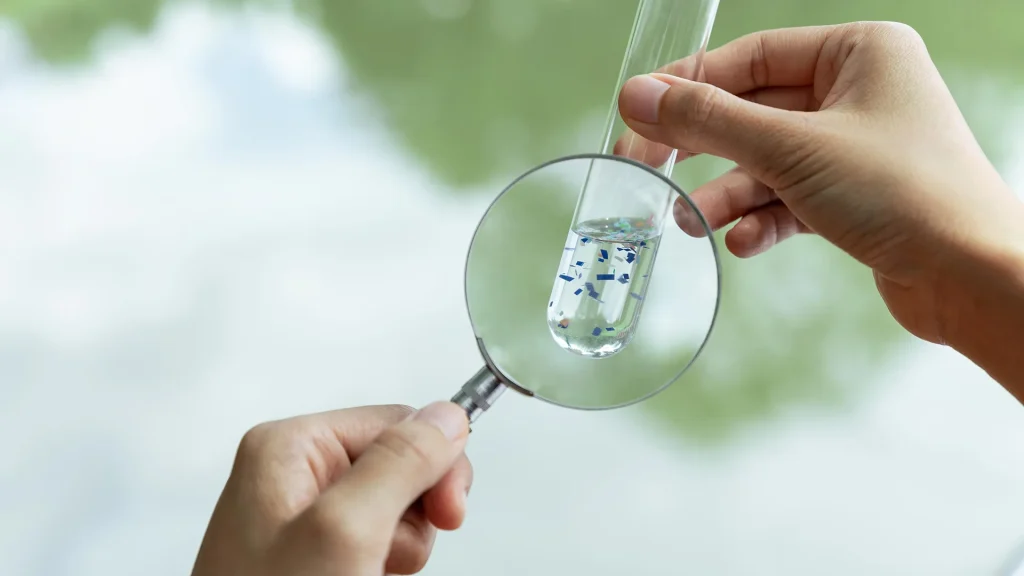The accumulation of microplastics in the environment, and within our bodies, is an increasingly worrisome issue. But predicting where these ubiquitous particles will accumulate, and therefore where remediation efforts should be focused, has been difficult because of the many factors that contribute to their dispersal and deposition.
New research from MIT shows that one key factor in determining where microparticles are likely to build up has to do with the presence of biofilms. These thin, sticky biopolymer layers are shed by microorganisms and can accumulate on surfaces, including along sandy riverbeds or seashores. The study found that, all other conditions being equal, microparticles are less likely to accumulate in sediment infused with biofilms, because if they land there, they are more likely to be resuspended by flowing water and carried away.
The open-access findings appear in the journal Geophysical Research Letters, in a paper by MIT postdoc Hyoungchul Park and professor of civil and environmental engineering Heidi Nepf. “Microplastics are definitely in the news a lot,” Nepf says, “and we don’t fully understand where the hotspots of accumulation are likely to be. This work gives a little bit of guidance” on some of the factors that can cause these particles, and small particles in general, to accumulate in certain locations.
Most experiments looking at the ways microparticles are transported and deposited have been conducted over bare sand, Park says. “But in nature, there are a lot of microorganisms, such as bacteria, fungi, and algae, and when they adhere to the stream bed they generate some sticky things.” These substances are known as extracellular polymeric substances, or EPS, and they “can significantly affect the channel bed characteristics,” he says. The new research focused on determining exactly how these substances affected the transport of microparticles, including microplastics.
The research involved a flow tank with a bottom lined with fine sand, and sometimes with vertical plastic tubes simulating the presence of mangrove roots. In some experiments the bed consisted of pure sand, and in others the sand was mixed with a biological material to simulate the natural biofilms found in many riverbed and seashore environments.
Water mixed with tiny plastic particles was pumped through the tank for three hours, and then the bed surface was photographed under ultraviolet light that caused the plastic particles to fluoresce, allowing a quantitative measurement of their concentration.
The results revealed two different phenomena that affected how much of the plastic accumulated on the different surfaces. Immediately around the rods that stood in for above-ground roots, turbulence prevented particle deposition. In addition, as the amount of simulated biofilms in the sediment bed increased, the accumulation of particles also decreased.
Nepf and Park concluded that the biofilms filled up the spaces between the sand grains, leaving less room for the microparticles to fit in. The particles were more exposed because they penetrated less deeply in between the sand grains, and as a result they were much more easily resuspended and carried away by the flowing water.
“These biological films fill the pore spaces between the sediment grains,” Park explains, “and that makes the deposited particles — the particles that land on the bed — more exposed to the forces generated by the flow, which makes it easier for them to be resuspended. What we found was that in a channel with the same flow conditions and the same vegetation and the same sand bed, if one is without EPS and one is with EPS, then the one without EPS has a much higher deposition rate than the one with EPS.”
Nepf adds: “The biofilm is blocking the plastics from accumulating in the bed because they can’t go deep into the bed. They just stay right on the surface, and then they get picked up and moved elsewhere. So, if I spilled a large amount of microplastic in two rivers, and one had a sandy or gravel bottom, and one was muddier with more biofilm, I would expect more of the microplastics to be retained in the sandy or gravelly river.”
All of this is complicated by other factors, such as the turbulence of the water or the roughness of the bottom surface, she says. But it provides a “nice lens” to provide some suggestions for people who are trying to study the impacts of microplastics in the field. “They’re trying to determine what kinds of habitats these plastics are in, and this gives a framework for how you might categorize those habitats,” she says. “It gives guidance to where you should go to find more plastics versus less.”
As an example, Park suggests, in mangrove ecosystems, microplastics may preferentially accumulate in the outer edges, which tend to be sandy, while the interior zones have sediment with more biofilm. Thus, this work suggests “the sandy outer regions may be potential hotspots for microplastic accumulation,” he says, and can make this a priority zone for monitoring and protection.
The work was supported by Shell International Exploration and Production through the MIT Energy Initiative.

